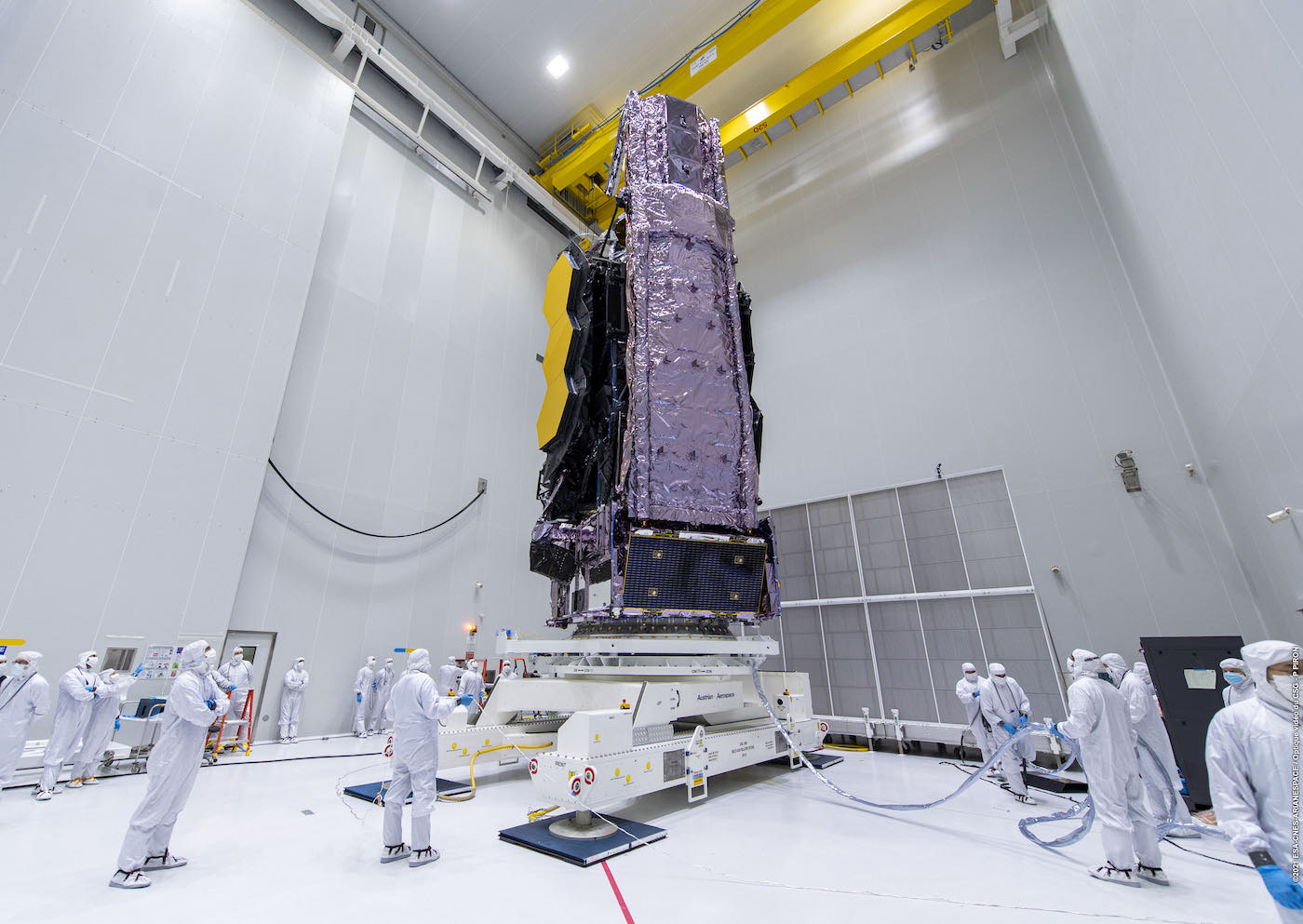Space News & Blog Articles
Webb telescope launch delayed to investigate clean room incident
 The James Webb Space Telescope inside its clean room in French Guiana. Credit: ESA/CNES/Arianespace/P. Piron
The James Webb Space Telescope inside its clean room in French Guiana. Credit: ESA/CNES/Arianespace/P. Piron
NASA said Monday the launch of the $9.7 billion James Webb Space Telescope will be delayed at least four days until no earlier than Dec. 22 out of “sheer caution” to ensure the observatory suffered no damage from vibrations during a processing incident at its launch site in French Guiana.
Ground teams are retesting parts of the observatory to make sure all systems remain healthy for launch aboard a European Ariane 5 rocket next month. The launch was previously scheduled for Dec. 18.
NASA said technicians were preparing to attach the 35-foot-tall (10.66-meter) James Webb Space Telescope to the launch vehicle adapter, a device that connects the observatory with the upper stage of the Ariane 5 rocket. The adapter has a clamp band system that secures the spacecraft to the rocket until the command to separate Webb about a half-hour after liftoff.
In a written update Monday, NASA said a “sudden, unplanned release” of the clamp band during processing in French Guiana “caused a vibration throughout the observatory.”
“It’s a clamp band with very high tension,” said Thomas Zurbuchen, associate administrator for NASA’s science mission directorate. “In doing so, we had an anomaly. That clamp band came off in a way that the clamp band is not designed to come off.”
RUAG Space, a Swiss company that specializes in building rocket structures and other components, supplied the payload adapter system for the Ariane 5 rocket and Webb, according to posts on the company’s social media pages.
The processing work inside the S5 payload facility at the Guiana Space Center is being performed under the “overall responsibility” of Arianespace, the French launch services provider for the Ariane 5 program. The European Space Agency, a junior partner on Webb, is paying for the launch as part of its contribution to the mission.
NASA said it is leading an anomaly review board to investigate the incident.
“When you work on a $10 billion telescope, conservatism is the order of the day,” Zurbuchen said.
Engineers analyzed the potential energy that could have been transferred into the Webb observatory when the clamp band released.
“Just for sheer caution, what we have done after these calculations is gone back to a small number of subsystems to just do the functional tests … just to be sure that nothing happened as this energy went into the bus,” Zurbuchen said. “That’s what we’re working on. That’s why we need a few extra days.
“We’ve always said that we will launch this telescope when we’re absolutely ready to go,” he added. “The right thing to do right now is to do these tests to make sure that everything is ready as we think they are. I hope that in just a few days here we will be in good shape … We’ll keep you informed as we go forward with it.”
NASA said it will release another update on the Webb launch campaign when the testing is completed at the end of this week.
The James Webb Space Telescope is folded up in launch configuration to fit inside the 17.7-foot-wide (5.4-meter) payload fairing of its Ariane 5 rocket. Once in space, the observatory will unfurl a power-generating solar panel and a high-gain communications antenna, then start a series of make-or-break deployments of its five-layer sunshield, which will open to the size of a tennis court.
Webb has 18 gold-coated beryllium mirror segments that will combine to create the largest telescope mirror ever sent into space, with a diameter of 21.3 feet (6.5 meters). Some of the mirrors are mounted on deployable wings that must fold into place to configure the telescope for science observations.
Then the telescope’s infrared detectors have to cool down to cryogenic temperatures, with parts of the instruments chilled to near absolute zero at a temperature of 7 Kelvin (minus 447.1 degrees Fahrenheit).
The telescope’s mirror segments each have tiny mechanical actuators to adjust focus and alignment.
The design makes Webb the most expensive and most complex science mission ever launched into space.
Email the author.
Follow Stephen Clark on Twitter: @StephenClark1.
When you subscribe to the SpaceZE News Feed, we will send you an e-mail when there are new updates on the site so you wouldn't miss them.

